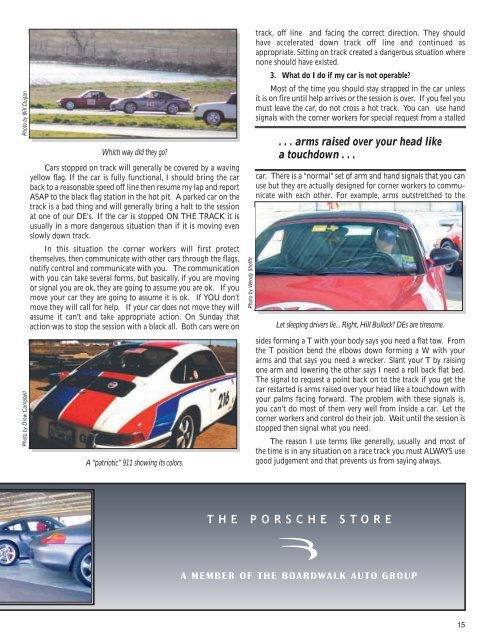Slipstream - April 2002
The monthly newsletter of the Maverick Region of the Porsche Club of America
The monthly newsletter of the Maverick Region of the Porsche Club of America
You also want an ePaper? Increase the reach of your titles
YUMPU automatically turns print PDFs into web optimized ePapers that Google loves.
Photo by Bill Dugan<br />
Photo by Drew Campbell<br />
Which way did they go?<br />
Cars stopped on track will generally be covered by a waving<br />
yellow flag. If the car is fully functional, I should bring the car<br />
back to a reasonable speed off line then resume my lap and report<br />
ASAP to the black flag station in the hot pit. A parked car on the<br />
track is a bad thing and will generally bring a halt to the session<br />
at one of our DE's. If the car is stopped ON THE TRACK it is<br />
usually in a more dangerous situation than if it is moving even<br />
slowly down track.<br />
In this situation the corner workers will first protect<br />
themselves, then communicate with other cars through the flags,<br />
notify control and communicate with you. The communication<br />
with you can take several forms, but basically, if you are moving<br />
or signal you are ok, they are going to assume you are ok. If you<br />
move your car they are going to assume it is ok. If YOU don't<br />
move they will call for help. If your car does not move they will<br />
assume it can't and take appropriate action. On Sunday that<br />
action was to stop the session with a black all. Both cars were on<br />
A “patriotic” 911 showing its colors.<br />
Photo by Wendy Shoffit<br />
track, off line and facing the correct direction. They should<br />
have accelerated down track off line and continued as<br />
appropriate. Sitting on track created a dangerous situation where<br />
none should have existed.<br />
3. What do I do if my car is not operable?<br />
Most of the time you should stay strapped in the car unless<br />
it is on fire until help arrives or the session is over. If you feel you<br />
must leave the car, do not cross a hot track. You can use hand<br />
signals with the corner workers for special request from a stalled<br />
. . . arms raised over your head like<br />
a touchdown . . .<br />
car. There is a "normal" set of arm and hand signals that you can<br />
use but they are actually designed for corner workers to communicate<br />
with each other. For example, arms outstretched to the<br />
Let sleeping drivers lie... Right, Hill Bullock? DEs are tiresome.<br />
sides forming a T with your body says you need a flat tow. From<br />
the T position bend the elbows down forming a W with your<br />
arms and that says you need a wrecker. Slant your T by raising<br />
one arm and lowering the other says I need a roll back flat bed.<br />
The signal to request a point back on to the track if you get the<br />
car restarted is arms raised over your head like a touchdown with<br />
your palms facing forward. The problem with these signals is,<br />
you can't do most of them very well from inside a car. Let the<br />
corner workers and control do their job. Wait until the session is<br />
stopped then signal what you need.<br />
The reason I use terms like generally, usually and most of<br />
the time is in any situation on a race track you must ALWAYS use<br />
good judgement and that prevents us from saying always.<br />
15


















